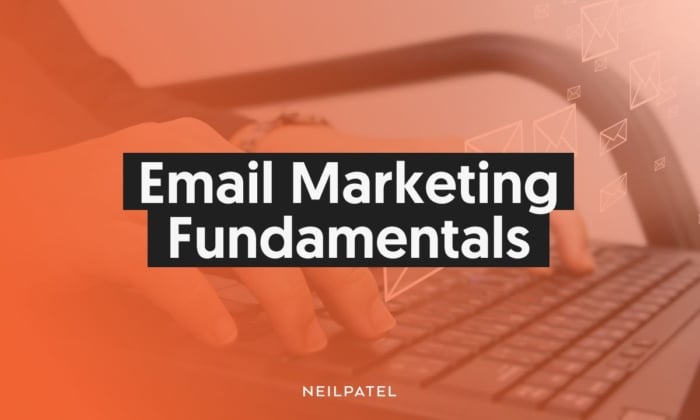
Do you use email marketing in your business? If not, you’re missing out.
It’s still one of the top ways to market to your audience. According to the State of Email Report from Litmus, 41 percent of marketers say email marketing is their most effective channel.
As the report highlights, email pays off big time in several ways. It allows you to segment and personalize campaigns. It works with every stage of the customer journey. And it’s a trusted channel for building connections and developing relationships.
What’s not to like?
This article is your guide to all things email marketing—from the fundamentals and best practices to how to start your own campaigns.
Ready? Let’s get to it.
Key Takeaways
- Email marketing is a strategy that helps you generate leads, nurture clients, and build relationships.
- Email marketing offers the benefits of targeting specific customers and greater personalization.
- A cost-effective strategy, email marketing delivers a return on investment (ROI) of 36 to 42 percent.
- Using email marketing effectively requires a personal touch. Add engaging, clickbait-free titles, and keep your messages brief (between 50 and 125 words).
- Before you start sending emails, you’ll need to start building your list. Collect email addresses by offering free incentives like checklists, templates, or eBooks in exchange for contact information.
What Is Email Marketing?
Email marketing is a digital marketing strategy that involves sending promotional messages or content to subscribers via email. This allows marketers to nurture relationships, generate leads, and drive sales.
What’s so great about it?
Although email is one of the oldest forms of digital communication, email marketing is one of the most effective digital marketing strategies out there.
Sure, there are newer methods for communicating with your audience and customers, like social media and live chat. However, with a user base of over 4.4 billion people and a market forecast projected to be worth over $35 billion by 2028, email is still the king of marketing channels.
Email marketing beats out social media, SEO, and affiliate marketing as the most impactful marketing channel.
Additionally, email marketing has a return on investment (ROI) of between $36 and $42 for every dollar you spend. Email clearly deserves a place in every marketer’s toolbox.
With all the hype over new channels, why is this decades-old technology still one of the most effective marketing strategies? Let’s take a closer look.
Why Is Email Marketing Important?
Despite the rise of social media, people use email more than other platforms. And good marketing is all about targeting the right platforms, isn’t it?
Data shows that most people are on email—and the number increases every year. What’s behind the popularity?
As I mentioned earlier, email marketing builds and strengthens customer relationships over time. That’s vital to growing your business because many consumers don’t buy at their first interaction.
Building trust over time is key. By using email to directly communicate with your niche audience, you can develop that trust.
The payoff? Because you’ve won their loyalty, subscribers will be more likely to convert.
Email marketing is also:
- Cost-effective: Sending emails is more affordable than launching traditional marketing channels like direct mail.
- Highly targeted: Email segmentation allows you to target customers effectively, meaning they’re more likely to convert.
- Good for click-throughs: Emails provide a direct route to your website and can boost sales. Depending on the type of marketing message, they have a click-through rate (CTR) of 1 to 5 percent and a conversion rate of up to 7.2 percent.
In addition, with email marketing, you own the connections—you don’t have to worry about algorithm changes tanking your reach.
Still not convinced? According to HubSpot, four out of five marketers say they’d rather give up social media than email marketing.
That’s why building a successful email marketing campaign is more important than ever.
The problem is most people don’t know how to do it right. (In fact, you’ve probably seen those people’s work in your email inbox.)
This post is long, but it’s worth reading. We’ll discuss tips and strategies for building an email list, creating an email that users want to read, designing automated campaigns, and tracking your efforts.
How Does Email Marketing Work?
Email marketing is one of the top-performing marketing strategies, in no small part because it’s fairly intuitive and often automated.
It can also support several other marketing initiatives, including lead generation, sales, and content marketing.
An effective email marketing campaign requires three essential elements:
1. An Email List
An email list is a database of subscribers who have agreed to let you send them emails.
To build successful email campaigns, you need a list of active, engaged email users.
There are many ways to build an email list. One of the easiest is to create a lead magnet (also called an offer) that your target audience is interested in. A common example is offering a coupon in exchange for email addresses.
2. An Email Service Provider
An email service provider (ESP), also known as an email marketing platform, is software that helps you manage your email list and design and execute automated email campaigns.
You can use an ESP to create automatic triggers when your audience completes specific actions, such as sending a cart reminder if a user adds an item to their cart and doesn’t check out. These triggers enable you to personalize interactions to improve engagement and open rates.
3. Clearly Defined Goals
An effective email marketing strategy helps you achieve a variety of business goals, including:
- Driving sales
- Boosting brand awareness
- Generating and nurturing leads
- Keeping customers engaged
- Increasing customer loyalty and lifetime value
To execute an effective email marketing campaign, your email list, ESP, and goals must align. Then, you can get to work:
- First, segment your email list according to subscriber demographics or actions.
- Next, create an email or series of emails designed to get consumers to do something (your goal).
- Finally, use your ESP to send emails and monitor the campaign automatically.
Advantages and Disadvantages of Email Marketing
As with any other marketing channel, email marketing has pros and cons. Let’s briefly dive into some of the more significant ones:
Advantages of Email Marketing
There are plenty of advantages to email marketing. These are just a few of the top benefits to keep in mind.
- It’s permission-based: When a customer trusts you with their email address, it’s the virtual equivalent of being given the keys to their house. Gaining permission to enter rather than showing up uninvited increases the chances of engagement and conversion.
- It provides direct access to your audience: You can communicate directly with subscribers on their schedules. Plus, because most people check email multiple times daily, subscribers are more likely to view your message.
- Email provides more control: With most other marketing platforms, you don’t own the platform. If the platform ceases to exist, all your hard work sinks with it. If Google or Facebook updates their algorithm, your reach could take a hit. However, with email, you own the relationships you forge with your subscribers.
- It offers more personalization capabilities: You can use demographic or psychographic data to create personalized and hyper-targeted campaigns. Research shows segmented and personalized campaigns increase revenue by as much as 760 percent.
- It’s easy to measure success: Measuring the effectiveness of a marketing campaign is crucial, and automated email marketing makes measuring your campaign a breeze.
- It’s scalable: Email marketing campaigns can easily scale as your audience grows without straining your resources or compromising quality.
Disadvantages of Email Marketing
Email isn’t all roses and butterflies. There are a few disadvantages to be aware of. The good news is a great strategy can reduce the impact of disadvantages, which include:
- The competition is tough: Standing out in a cluttered inbox can be challenging. You’ll need to get creative to ensure your subscribers open your emails.
- You need an email list: For email marketing campaigns to be effective, you must already have an email list. Building an email list can be tricky and takes time.
- There are many rules and regulations to navigate: Several laws govern the use of email for commercial purposes. Common examples include the General Data Protection Regulation (GDPR), CAN-SPAM, and the California Consumer Privacy Act (CCPA). Unfortunately, some subscribers might report your emails as spam even if they subscribe. As a result, your sender reputation takes a hit.
- Delivery and deliverability issues: Deliverability is not guaranteed. Many email providers (think Gmail or Outlook) use spam filters. To run effective email marketing campaigns, you must contend with delivery and deliverability issues.
The Fundamentals of Email Marketing
Before diving into the strategies you’ll use to build and leverage email marketing for e-commerce, let’s cover the fundamentals. These tips will help you maximize your email marketing campaign, which we’ll discuss next.
Email marketing is popular—which also means it is competitive. Use email to speak directly to your users, use their names, and let them see the human side of your brand.
1. Stay Human
Showing your human side is an absolute must if you want to gain loyal customers and increase conversions. Why? Because research shows that readers are 26 percent more likely to open personalized subject lines.
Consumers like to feel that you’re talking to them personally. The way you address them can make all the difference.
2. Use Engaging Titles, But Don’t Bait and Switch
Interesting subject titles are crucial to increasing email open rates, but keep them on topic and non-spammy. If users feel duped, they’re likely to unsubscribe or mark your message as spam, which impacts deliverability.
To prevent this, concentrate on creating subject lines that reflect the content of your emails and use action-oriented language. It’s OK to use emails that cause a sense of urgency or excitement, but avoid exaggeration.
Use subject lines like:
- Don’t miss out on this limited time offer!
- Join the community today and exclusive perks
- Last chance to save
- You’re invited
Just ensure you use accurate headlines so you don’t disappoint subscribers when they click through.
3. Keep Messages Short
Many consumers read their emails on a mobile device, so keep your copy concise and to the point. One suggestion is to keep your emails between 50 and 125 words. It’s also worth noting that emails of up to 50 words can have up to a 50 percent conversion rate, according to Campaign Monitor.
If you need to add more info for context, then use easy-to-scan bullet points or numbered lists.
Direct users to a blog post or landing page if you need to share a ton of information. Doing this keeps your emails concise and lets readers access the content in their own time.
4. Include CTAs at the Top and Bottom
On landing pages, calls to action (CTAs) generally appear above the fold. Use the same strategy with email marketing by including strong CTAs after the first paragraph and again at the end.
Adding an engaging CTA after the first paragraph makes it easier to grab your subscribers’ eye and encourage them to convert. Then, include a follow-up CTA at the end of your email reminding the subscriber to act.
Avoid overusing CTAs, though, or you’ll overwhelm your reader. Keep it to two or three, max.
5. Ask Permission and Deliver On Your Promises
Never buy email lists—that is illegal in most cases and won’t deliver ROI. If you offer a great deal or high-quality content, make sure to deliver just that.
If you do buy an email list, know that you’re likely to get a low response rate. Why? Because you’re reaching out to people who haven’t opted in and have little interest in your offer.
A better approach is creating your email list organically by providing valuable content, tailored offers, or incentives. To improve engagement, don’t just try to sell. Instead, draw people in with stories or solutions to their problems.
Finally, add a double-opt-in for your new subscribers, and make it easy for your list to unsubscribe.
Getting Started With Email Marketing
Email marketing strategies enable businesses to send promotional messages to large numbers of people. Typically, marketers use it to generate sales by sharing promotional offers, nurturing leads, or expanding the impact of content marketing efforts.
If you open your email inbox right now, there’s a good chance at least half your messages are email marketing, like this one from GlassesUSA:
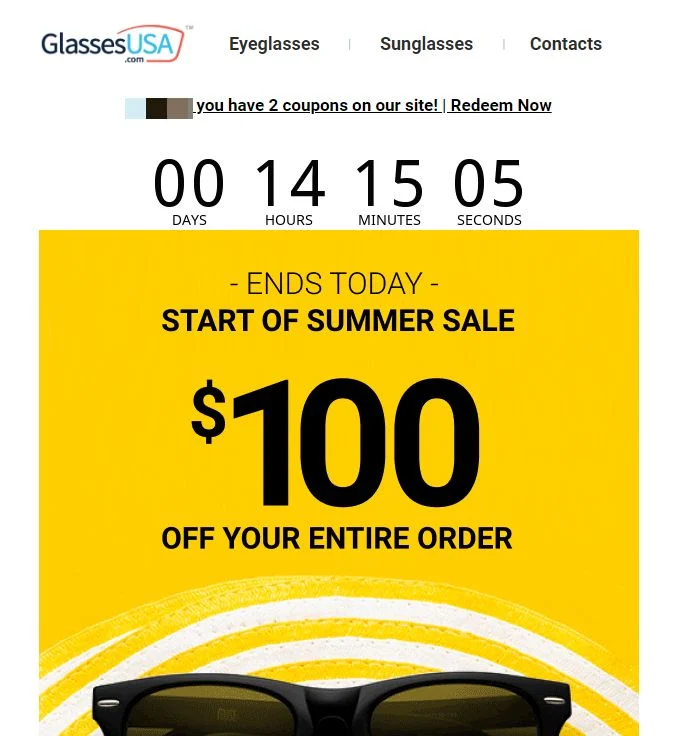
1. Build Your List
Before you can start sending emails, you need people to send emails to. That’s where building your list comes in. Start by adding a banner or form to your website simply asking people to subscribe.
Then, follow these tips.
1. Offer An Incentive
Think of email addresses as a currency: You wouldn’t give money away, right? Offering an incentive is a simple way to gather email addresses.
There are many ways you can do this. Some prefer to give away downloadable assets or offer coupons, while other businesses simply offer a newsletter or product updates.
For example, the business newsletter Morning Brew offers readers a simple benefit: fun, interesting updates every morning.
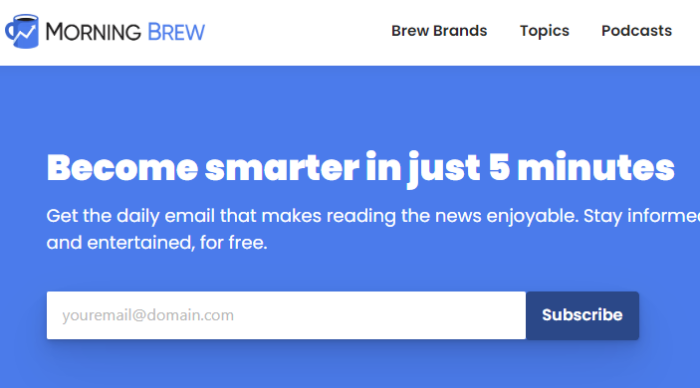
Search Engine Journal uses a small form in their right sidebar offering daily news—it also asks which topics interest the user, which helps them send more valuable content.
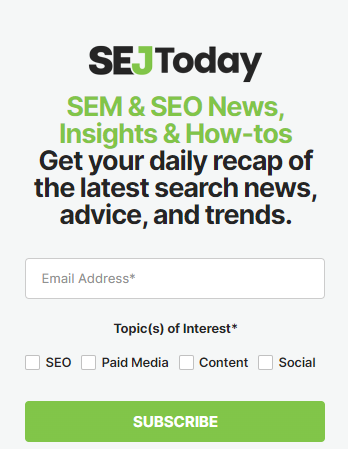
You can also offer a checklist, eBook, white paper, or another downloadable asset. Contests and giveaways are other great ways to convince people to share their email addresses. This is where a strong call to action comes into play. Copywriting is super important, too.
Simply posting “enter your email for updates” isn’t going to get anyone excited. Instead, share specifics.
You’ll attract more subscribers by sharing a specific CTA or benefit from providing their email addresses.
Common ways to entice people to sign up to your email list include:
- Email series
- Free downloads
- Free white papers or eBooks
- Update lists, like new releases and product updates
Whatever incentive you offer, make it clear and enticing, and don’t be afraid to promote it.
2. Follow Email Marketing Laws and Regulations
Make sure your emails follow local rules and regulations, including CAN-SPAM and GDPR.
Don’t let all the legalese scare you.
All this means is you can never buy email lists, and you should consider using double-opt-in options so people know what they’re getting into. Finally, make it easy for people to unsubscribe.
2. Provide Great Content
Email marketing is all about expectations. It’s up to you to set them.
If your CTA is strong and your follow-up consistent, then you can count on a successful email campaign.
However, if you promise to send one email per week and instead send it daily, you’re setting yourself up for failure. (And annoying your list.)
On the contrary, if someone is expecting daily updates or critical product updates and you don’t deliver, they are likely to be upset in that case, too.
This is why the first follow-up email is so crucial to the success of your email marketing efforts. Here’s how to do it:
1. Send an Introduction Email
Here’s a basic welcome email from Airbnb to a new customer. It highlights the millions of places to stay, the hundreds of thousands of cities and countries, and the over 220 countries and regions. The email ends with a compelling CTA to inspire readers to click through.
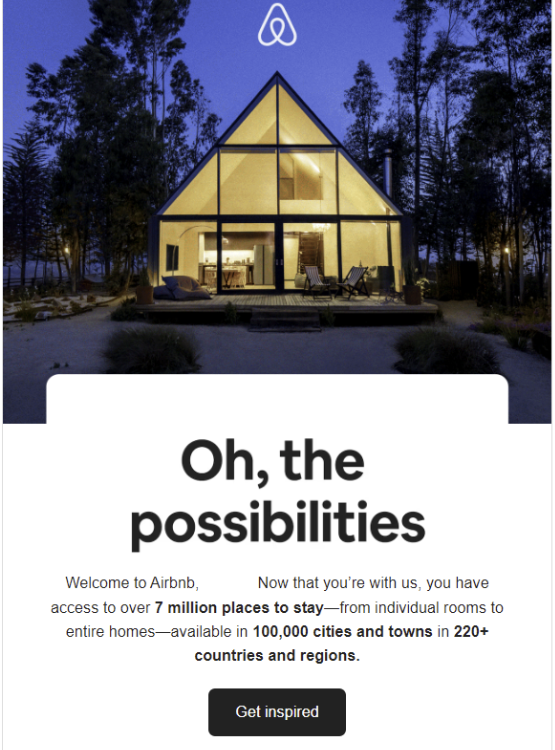
Spotify sends out a similar email that confirms a subscription and lets the subscriber know what they can expect.
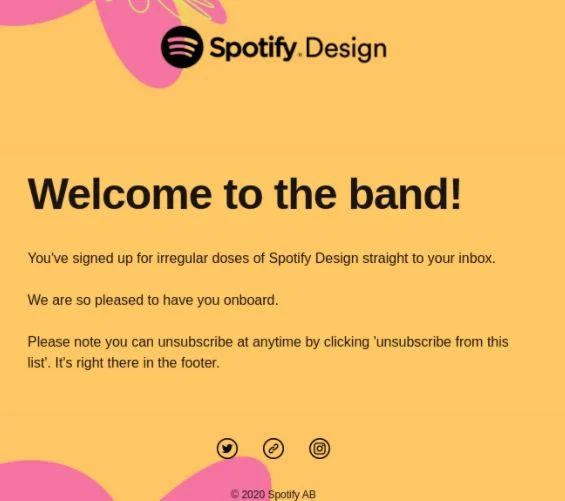
Almost all email service providers allow you to create an automated welcome sequence, so take advantage of it.
You should send the initial follow-up email immediately to introduce yourself and explain what new subscribers should expect.
In this first email, it’s better to provide detailed content, but if you can pull it off quickly and concisely, then more power to you.
2. Don’t Pitch Right Away
You’re not running an email list just for fun—you want to engage customers and make sales.
Transitioning from an email list that provides tons of free value into a list that pitches a product for money can be tricky.
To do it effectively, consider how and when you’ll send the pitch. You don’t want to suddenly surprise everyone with a pitch.
Your campaign will be much more successful if people expect sales pitches every once in a while.
Again, each business has different needs, so there aren’t any hard and fast rules for how often you can pitch or provide content.
Just remember that an email list is an asset, and it’s better to err on the side of caution than to be reckless.
3. Learn How to Write a Great Email Newsletter
Let’s talk about the difference between a good newsletter and a bad newsletter.
The first sign you’ve received a bad newsletter is you don’t recall asking to receive it.
Typically, this happens when a business either fails to maintain a regular email routine or manually adds someone to their list after receiving a business card or personal email.
Make sure everyone remembers you. The best way to do this is to send regular updates. Try to send an email at least once a month or once a week if you can.
I find the most compelling newsletters are those that do a great job of mixing messaging and updates.
For example, while the email might contain a list of product updates and images, it’s balanced by a personal message or friendly memo.
Use your newsletter to further your relationship with the reader or customer rather than to pitch them.
Save the pitch for unique updates, offers, and announcements.
4. Use Email Automation, But Keep It Human
If you’re just starting your email list, it’s easy to imagine that you’ll have time to personally respond to every new subscriber.
But once you have more than a handful of subscribers, keeping up your email marketing becomes next to impossible.
You’ll start building more complex campaigns, and following through with everyone all the time is impossible.
Top marketers seem to pull this off, but how?
Their secret is email automation.
This automatically sends out emails scheduled in advance and sends emails based on triggers.
By scheduling a set of emails to send in advance, you can prevent “going dark” for any length of time.
Often, companies plan a series of emails—ranging from a few days to a few months—that automatically deliver, warming up anyone who signs up for their list.
That way, when you do need to announce a new product or sale, you know they are paying attention.
3. Analytics and Segmentation
Now that you understand the basics of an effective email campaign let’s discuss taking things to the next level with targeted email marketing.
Specifically, we’ll talk about using segmentation and analytics to refine your broadcasts and generate even better results.
Below are some of the fundamentals:
1. Embrace Email Analytics
We’ve discussed the importance of analytics in web copy, and email is no different.
Every email service provider I’ve ever worked with provides complimentary analytics.
Though all metrics are important, the three most important are open rate, click-through rate, and unsubscribes.
Let’s break down each one and see what you can learn from these metrics.
- Email open rate: Your open rate indicates how many people open your emails. Open rates tell you how good your relationship is with your subscribers. If your open rate is low, it usually means you have many unengaged subscribers. You need to focus on providing value and managing expectations. Here are a few tips on raising your open rate.
- Click-through rate: Your CTR shows how many people clicked on a link in your email. If your CTR is low, you are either not targeting your message well enough or simply not getting through. In this case, focus on improving your copy.
- Unsubscribe rate: Finally, your unsubscribe rate tells you how many people have clicked the “unsubscribe” button at the bottom of your email. If your unsubscribe rate is high relative to your opt-in rate, you have some serious work to do. View your email analytics for clues to what you’re doing wrong and make fixes from there. For instance, if a subscriber leaves after a marketing email, you might need to target your offers more precisely.
2. Decide How to Segment Your Email Marketing List
If you’re unfamiliar with the term, email segmentation is the practice of splitting up your email list into more targeted groups.
Here are a few ways to segment your list:
- Customer list (in comparison to leads who haven’t bought)
- Newsletter subscribers
- Daily email list (in comparison to weekly, bi-weekly, monthly, etc.)
- Demographics, such as age, location, or job title
- Interests, such as marketing or sales topics
Just like targeting in paid ads, dividing your list lets you send more targeted communications.
For example, some customers want product and sales updates, while others might only want to hear about new product updates. Sales team leads might want to hear about a new sales feature but not a new marketing tool.
Plus, you can send specific emails to buyers thanking them for their purchase, like this email from Chrome Industries thanking people for making a purchase.
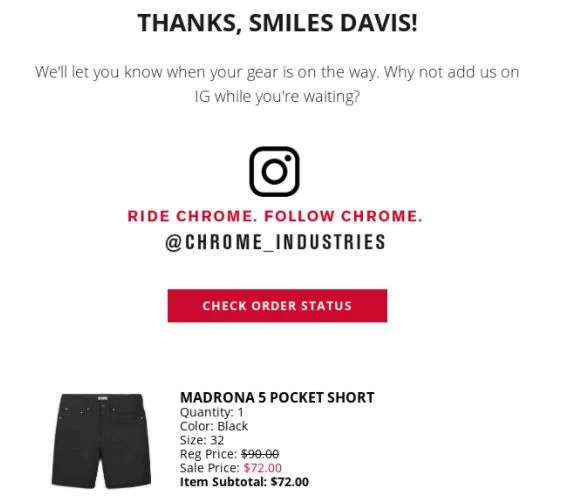
With segmentation, you can send a broadcast only to those who didn’t open your last message (ask them why) or to those who showed interest (a second pitch).
You can also split-test messaging among different groups to A/B test titles, content, or best practices.
3. Calculate How Much Is Your Email List Worth
Your email list is one of your most valuable resources. Treating it well will pay for itself many times over.
Over time, you can start tracking the average amount of money people on your list spend. This tells you how much your list is worth.
If a list of 10,000 people usually spends $50,000 on a campaign and you run two campaigns each year, you could average it out and say that each subscriber is worth $10 a year.
With math like that, it’s easy to see how losing several hundred subscribers could be dangerous to your bottom line.
FAQs
What are the benefits of email marketing?
Email marketing can help businesses reach a wider audience, drive sales, recover abandoned carts, and further develop your relationship with your audience. It’s also one of the most cost-effective marketing strategies.
How do I build an email list?
Build your email list by offering a downloadable asset, hosting a giveaway, or offering a free email course. You might also consider placing a banner at the top of your site to gather emails.
What email marketing regulations are there?
CAN-SPAM and GDPR (for Europe) require you to protect user’s privacy and avoid sending emails to purchased lists.
What is email automation?
Email automation allows you to create complex email campaigns that send automatic emails based on actions, such as when a subscriber adds an item to their cart or downloads an asset.
How do I segment my email list?
Use your email tool to split subscribers based on demographics, interests, or customers versus non-customers. Then, send customized messages to each segment.
Are there different types of email marketing campaigns?
Yes. One example is a regular newsletter. Other types of email marketing include welcome or onboarding, follow-up, promotional, informational, and survey emails. You can also send automated emails to re-engage customers or encourage them to complete a transaction (abandoned basket emails.)
If you’ve been ignoring email marketing or putting your strategy on autopilot, it’s time to step up your strategy and learn how to do email marketing the right way.
Email marketing delivers huge returns for marketers who put in the time to do it right.
It doesn’t have to be complicated.
First, remember you’re a guest in your subscribers’ inboxes. You’re just one click away from losing their interest forever. Be polite and respectful, and deliver value.
Also, be sure to follow through on the promises you make. Provide people with what they’ve asked for and email regularly to meet their expectations.
Automation can help you deliver on those expectations.
There’s no formula for boosting email automation. It’s all about what works best for you and your company’s voice and style.
Finally, once you’ve mastered email marketing basics, you can move on to email segmentation and analytics.
Continue reading...
